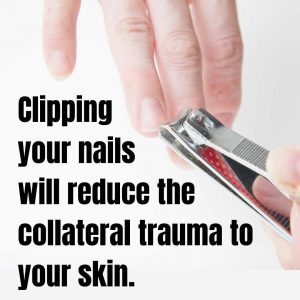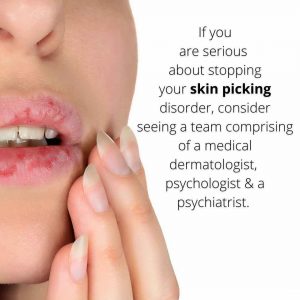- Best ResultsVariable
- Treatment RecoveryVariable
- Procedure Time1-5 minutes
- Skin SpecialistYou with help from me
- Duration of ResultsUp to you
- AnaestheticNA
- Back to WorkNA
- Cost$
Skin Picking Disorder: Wound Care
Correct wound dressings & care can markedly reduce scars from chronic skin picking. Gouges, scratches & ulcers heal better in a sterile yet moist environment. Simple steps including regular trimming of nails can markedly decrease the damage to your skin. Hydrocolloid dressings are cost-effective & invaluable.
FactsFacts on Skin Picking Disorder Wound Care
- Prevention of permanent scarring is the primary focus of wound care
- Disinfect picking areas with chlorhexidine, iodine, Bactroban or Fucidin
- Provide a moist but sterile atmosphere for wound healing
- Compression bandages can reduce picking
- Taped cotton gloves are invaluable
- Hydrocolloid patches can reduce picking of spots
- Early scar treatments can mitigate permanent scarring
Why is wound care so important?
Because it can prevent infection & reduce scars. If you are not open to help, at least I can help you reduce permanent scarring. This is super important as skin picking scars can be bloody challenging to treat, especially hypopigmented scars. By reducing scars, my team & I may have an easier job when it comes to helping you, should you require scar revision.
Skin picking leads to loss of collagen as well as pigmentation changes – either darkened scars, or loss of colour (deeper scars).
How to reduce or prevent infection?
If you develop an infection in picked scars, your rate of permanent scarring exponentially rises. You can prevent or more accurately reduce infection by-
- Cleaning your wounds with chlorhexidine or iodine. Do not use alcohol as it stings. Ideally clean once a day, using a sterile dressing pack. Look on eBay or Amazon.
- Apply antibacterial ointments such as Bactroban, or Bepanthen
- Use appropriate wound dressings, such as Melolin, Bactrigras, Opsite- ask a pharmacist
- Wrap the area in Tubi grip. Obvious not an option of you have skin picking wounds on your face
- For facial lesions, clean as above, then apply acne hydrocolloid patches. The patches provide a clean & moist environment for wounds to heal. They also act as a way of giving you haptic feedback if you re-pick these spots
What’s the deal with nails & gloves?
A time-tested trick that dermatologists employ is to get you to cut your nails really short. This reduces the urge/ability to gouge.
If you continue to pick at night, wear some cotton gloves. Get your partner-family-friends to use duct tape to secure them. If you feel the urge to pick, you could try techniques like habit reversal training.
Can phototherapy heal skin picking scars?
Yup. There are two forms of phototherapy. Medical phototherapy uses a special light source called narrowband UVB. This treatment can reduce the urge to pick by stabilizing inflammatory & mast cells, reducing histamine release. This treatment is covered under Medicare.
Light in the form of yellow & red light can be useful for acute wounds. This type of phototherapy is not covered under Medicare. My nurses & dermal therapist perform this form of light treatment.

View our Treatment Gallery
Are branded zit patches better than normal patches?
As mentioned, the single most useful tool is an acne patch, or hydrocolloid dressing. You do not need to buy Hero Patches or Zit Sticka, as these are more about marketing, & packaging over medical therapy. You can purchase hydrocolloid dressings for less than one fifth the price of these brands. In the acute phase of wound management, it is about time & numbers over microdart technology with time released skin care actives.
Get yourself some hydrocolloid acne patches from any pharmacy. Don’t pay more than 5-7 dollars for a box. Invest in a few boxes as most likely you will go through a sh*t load of desssings, especially if you are a prolific skin picker.
What is a microdart & how is it different from normal patches?
I really love the technology of microdarts. The best darts come out of South Korea. Darts are essentially time-released acne patches with skincare actives such as pigment correctors (vitamin C, arbutin, citric acid, kojic acid), as well as exfoliators (mostly BHA salicylic acid). Each patch contains 40 – 200 micro darts that penetrate the stratum corneum (top layer of skin). Over 4-8 hours, the darts release goodies as described into the epidermal layer of your skin.
The role of these darts can be considered when your acute picking wound or ulcer re-epithelialized. The best/fastest/ most effective/ cost effective way of healing an open wound is with hydrocolloid dressings, not with micro darts.

How to prevent hyperpigmented scars?
Skin picking will leave scars of some sort. Hyperpigmented scars are almost universally seen in Asian & ethnic patients. They occur when the superficial layers of skin are picked. Fortunately, most will fade within 6-18 months. Dig deeper & hypopigmented scars can result. This occurs because pigment cells are gouged out (they are supposed to reside in the epidermis & not under your fingernails).
PIH or pigment can be reduced with adequate sunscreen application. When the skin is completely healed, pigment inhibitors such as abrutin, kojic acid, vitamin C, niacinamide, liquorice root & botanicals can help.
I use lasers such as pico, nano & fractional to treat PIH. Treating the primary source of picking gives permanent results.

What can be done with hypopigmented or white scars?
If you have this type of scarring, you have removed the pigment cells in the upper parts of skin. Hypopigmentation is much harder to treat compared to other skin scars. You can try sensible DIY microneedling at 0.2 mm. Add tacrolimus or bimatoprost topically. See the section on home treatments.
Failing that, my team at Cutis can employ other lasers & topicals, including phototherapy. I am the final step in scar revision as I use surgical methods of melanocyte transfer.
How can you reduce the urge to pick your skin?
Simple mind exercises such as cognitive behaviour therapy, habit reversal therapy and acceptance & commitment therapy can help reduce your urge to pick. A clinical psychologist can help. You can also practice these techniques at home. There are heaps of informative videos on YouTube.

How to treat chronic wounds?
My suggestion is to get skin picking under absolute remission before the task of chronic wound management. Remission may take 2 to never (depending on your insight & your willingness to undertake therapy, either self-therapy or by a professional). The more insight you have, the faster the recovery.
Treating your scars will depend on the pattern of scarring you exhibit with skin picking. See below for more information.
How to treat depressed divots from picking?
This is challenging. You can try DIY microneedling with a derma stamper. Do not try to go deeper than 0.2 mm on your face, you may cause more harm than good.
If you compromise the skin’s barrier whilst you still have active picking, you may expose yourself to infection & scarring.

How to treat white scars?
Hypopigmented scars are usually from chronic skin picking wounds. Chances are you have gone deep. This pattern is also seen in cases of acne excoriee & drug induced skin picking, usually ice – methamphetamine.
Briefly, the use of microneedling & pigment stimulators such as tacrolimus or Latiesse are first line, followed by lasers then phototherapy & surgery.
How to get help?
For acute picking & infection prevention, a wound specialist can assist. A family physician is often the first health professional you should see.
Here is the catch- they may or may not know about skin picking disorder or dermatillomania. If they know how to manage (psychotherapy, SSRIs etc…), then you are in good hands. If they don’t, escalate your concerns. Your first port of call can either be a general dermatologist, a psychologist who specializes in OCD, or a psychiatrist who has an interest in treating this condition.
If you are in Brisbane, my colleagues at Cutis can help. We refer patients to the OCD Clinic in Bulimba.
Disclaimer: I am a procedural dermatologist. Skin picking disorder is a commonly treated skin condition that is seen by my medical colleagues, I intervene at the end to fix up scarring.
What is the psychology behind skin picking disorder?
It’s complex. If you understand why you pick, it may give you better insight & seek professional help. Skin picking can be viewed as a combination of OCD as well as a self-gratifying condition. In many cases it is impossible to stop picking. Picking also makes you feel better (during the act), then you feel guilty, & the cycle continues.
I get it, but I am bad at counselling patients. You do need to see someone who has the skill sets & time to walk you through the healing process. If you are open to it, you will get better. If you deny that you have a problem, your condition will be chronic & have a major impact on your quality of life.

What is the cost of simple wound care for skin picking?
Not much. As reinforced, the best investment are hydrocolloid dressings. They start at 10 to 20 cents per patch. You do not need expensive brands.
A bottle of antibacterial wash is about 10 bucks, Tubigrip dressings are about 20-30 bucks. Melolin patches are about 3-5 bucks. Buy some Savlon or Bepanthen.
If you are serious about managing skin picking, get a referral to see a psychologist for CBT & HRT. Medicare & private health insurance subsidies visits. You need between 5 to 10 sessions to get it. Can’t afford it? Not motivated enough? Watch a few YouTube videos. In all seriousness, the sooner you get professional help, the better your life will be.
Davin’s Viewpoint on Skin Picking- how to manage wounds
The second step, after prevention of picking, is early & appropriate management of wounds. If you can find yourself a family physician who can look after your wounds in a specified wound care clinic, you are ahead. Failing that, the simple DIY treatments as listed above can make a significant impact on mitigating long term scarring.
Remember, it scabs its scars, & grease for peace. A moist & sterile wound environment is required for optimal scar remodelling. You don’t need expensive – fancy patches, simple hydrocolloid dressings will do. There are many videos on YouTube describing how to look after wound from picking & cutting.
I highly encourage patients to at least start CBT & habit reversal training at the same time as wound management. This will prevent further scarring & will herald the first steps to getting better.
Disclaimer: My team & I are a tertiary referral centre. We do not provide acute wound care; however, we can liaise with your GP or refer you to a public hospital for management.
